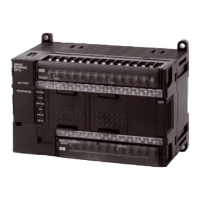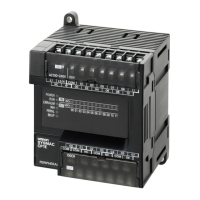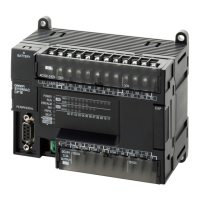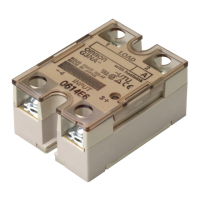114
Wiring CP1L CPU Units Section 3-4
Connecting I/O
Devices
Use the following information for reference when selecting or connecting input
devices.
DC Input Devices Connectable DC Input Devices (for DC Output Models)
• The circuit below should not be used for I/O devices with a voltage output.
Precautions when
Connecting a Two-wire DC
Sensor
When using a two-wire sensor with a 24-V DC input device, check that the fol-
lowing conditions have been met. Failure to meet these conditions may result
in operating errors.
1,2,3...
1. Relation between voltage when the PLC is ON and the sensor residual
voltage:
V
ON
≤ V
CC
− V
R
2. Relation between current when the PLC is ON and sensor control output
(load current):
I
OUT
(min) ≤ I
ON
≤ I
OUT
(max)
I
ON
= (V
CC
− V
R
− 1.5 [PLC internal residual voltage]*)/R
IN
When I
ON
is smaller than I
OUT
(min), connect a bleeder resistor R. The
bleeder resistor constant can be calculated as follows:
R ≤ (V
CC
− V
R
)/(I
OUT
(min) − I
ON
)
Power W ≥ (V
CC
− V
R
)
2
/R × 4 [allowable margin]
IN
COM
CP1L
+
+
IN
CP1L
5 mA/
7 mA
+
COM
⊕
+
IN
COM
CP1L
+
CP1L
COM
IN
IN
COM
CP1L
0 V
+
+
IN
COM
CP1L
+
+
Contact output Two-wire DC output
Sensor
power supply
NPN open-collector output
Sensor
power supply
Output
NPN current output
Current
regulator
Output
Sensor
power supply
PNP current output
Output
Sensor
power supply
Voltage output
Output
Sensor
power supply
0 V
5 mA/
7 mA
0 V
5 mA/
7 mA
0 V
IN
CP1L
0 V
+
COM
−
Output
Sensor
power supply

